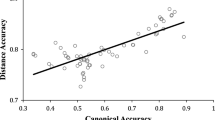Abstract
Sequence-space synaesthesia is a type of visuo-spatial imagery in which numbers or calendar units are experienced to occupy locations in space. Previous studies have claimed that these synaesthetes (1) have stronger self-reported visual (but not spatial) imagery and (2) perform unusually well on mental rotation tasks that are usually taken to reflect spatial (but not visual) imagery. To further investigate whether this form of synaesthesia is related to spatial imagery, we compared synaesthetes to controls on the Object Spatial Imagery Questionnaire, a paper folding test and a mental rotation task. The synaesthetes did not differ from controls in self-reported spatial imagery, but showed a strong trend to report better visual imagery, replicating previously reported data patterns. Consistent with this, their paper folding and mental rotation performance was no better than controls. We also confirmed that, in our pooled sample, performance on both these tasks was positively correlated with self-reported spatial imagery. We suggest our data are more consistent with the view that sequence-space synaesthesia is related to visual than to spatial imagery, and we suggest reasons why previous studies may have found superior mental rotation performance.



Similar content being viewed by others
Explore related subjects
Discover the latest articles, news and stories from top researchers in related subjects.References
Blajenkova O, Kozhevnikov M, Motes MA (2006) Object–spatial imagery: a new self-report imagery questionnaire. Appl Cogn Psychol 20:239–263
Eagleman DM (2009) The objectification of overlearned sequences: a new view of spatial sequence synaesthesia. Cortex 45(10):1266–1267
Ekstrom RB, French JW, Harman HH, Dermen D (1976) Kit of factor-referenced cognitive tests. Educational Testing Service, Princeton, NJ
Galton F (1881) Visualised numerals. J Anthropol Inst G B Irel 10:85–102
Gheri C, Chopping S, Morgan MJ (2008) Synaesthetic colours do not camouflage form in visual search. Proc R Soc B 275:841–846
Hegarty M (2010) Mechanical reasoning by mental simulation. Trends Cogn Sci 86:280–285
Hubbard EM, Piazza M, Pinel P, Dehaene S (2005) Interactions between number and space in parietal cortex. Nat Rev Neurosci 6:435–448
Hubbard EM, Brang D, Ramachandran VS (2011) The cross-activation theory at 10. J Neuropsychol 5:152–177
Kosslyn SM (2005) Mental images and the brain. Cogn Neuropsychol 22:333–347
Price MC (2009a) Spatial forms and mental imagery. Cortex 45:1229–1245
Price MC (2009b) What kind of mental images are spatial forms? Cogn Process 10(suppl 2):276–278
Price MC (in press) Synaesthesia, imagery and performance. In: Hubbard E, Simner J (eds) Oxford handbook of synaesthesia. Oxford University Press, Oxford
Price M, Mentzoni RA (2008) Where is January? The month-SNARC effect in sequence-form synaesthetes. Cortex 44(7):890–907
Reisberg D, Pearson DG, Kosslyn SM (2003) Intuitions and introspections about imagery: the role of imagery experience in shaping an investigator’s theoretical views. Appl Cogn Psychol 17:147–160
Santiago J, Lupianez J, Perez E, Funes MJ (2007) Time (also) flies from left to right. Psychon Bull Rev 14:512–516
Shepard RN, Metzler J (1971) Mental rotation of three-dimensional objects. Science 171:701–703
Simner J (2009) Synaesthetic visuo–spatial forms: viewing sequences in space. Cortex 45(10):1138–1147
Simner J, Mayo N, Spiller M-J (2009) A foundation for savantism? Visuo-spatial synaesthetes present with cognitive benefits. Cortex 45(10):1246–1260
Conflict of interest
This supplement was not sponsored by outside commercial interests. It was funded entirely by ECONA, Via dei Marsi, 78, 00185 Roma, Italy.
Author information
Authors and Affiliations
Corresponding author
Rights and permissions
About this article
Cite this article
Rizza, A., Price, M.C. Do sequence-space synaesthetes have better spatial imagery skills? Maybe not. Cogn Process 13 (Suppl 1), 299–303 (2012). https://doi.org/10.1007/s10339-012-0459-7
Published:
Issue Date:
DOI: https://doi.org/10.1007/s10339-012-0459-7




